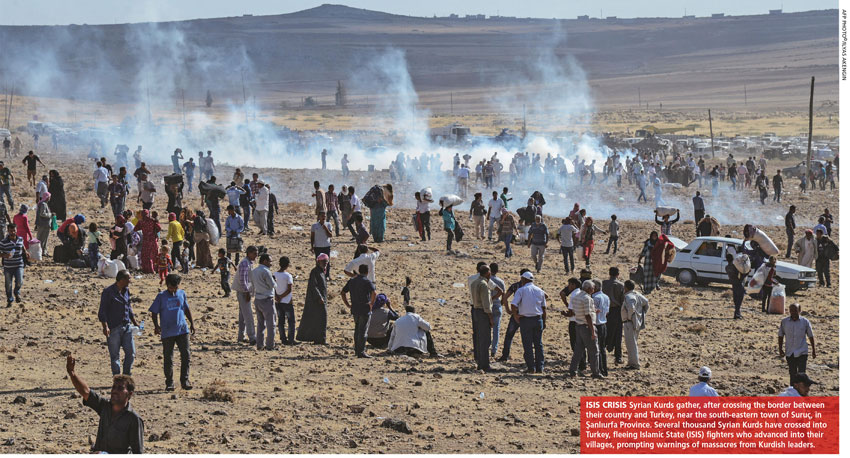ISIS IDEOLOGY
THE LURE OF ISIS: AN ANALYSIS
Saro Thiruppathy examines the nexus between social exclusion and ISIS’ recruitment
The Islamic State of Iraq and the Levant – alias Islamic State of Iraq and al-Sham (ISIS), now truncated to Islamic State (IS) – has caught many young Muslims the world over by storm. Tens of thousands of young adults are joining the ranks of this exceptionally cruel and intolerant group of jihadist fighters in Iraq and Syria.
Jihad refers to a struggle or resistance – “against nonbelievers,” according to the Oxford Dictionary. Persons engaged in jihad are known as Mujahideen. And thanks to the international media blitz on the ongoing war against ISIS, we are kept in the loop on ongoing action to decimate IS militants by the US and its allies, including a number of Arab states.
But the lead-up to this state of affairs is intriguing and troubling, to say the least.
The genesis of ISIS has its roots in the Iraq War waged by the US and its coalition partners, as it was an arm of al-Qaeda in Iraq. Rewinding back to 1999, the Jama’at al-Tawhid wal-Jihad was the father of al-Qaeda in Iraq (AQI). Abu Musab al-Zarqawi founded AQI in 2004, in response to the invasion of Iraq. It joined other Sunni terrorist groups and formed the
Mujahideen Shura Council, which is the predecessor of the present-day Islamic State.
ISIS continued to grow, evolving and gaining support in Iraq, due to what it alleged to be political and economic discrimination against the Sunni community in that country. ISIS then went into Syria, to join the rebel fighters and establish itself in major governorates. By mid 2014, some 4,000 disenchanted Muslims had joined its ranks in Iraq and killed thousands of civilians, in addition to destroying state and military targets.
By August, the Syrian Observatory for Human Rights claimed that the fighting strength of ISIS had risen dramatically to 50,000 in Syria and 30,000 in Iraq. However, at the end of September, according to a report in The New York Times, a more conservative estimate fielded by US intelligence placed this number at 15,000 fighters from 80 countries. This includes more than 2,000 Europeans and 100 Americans, it said.
ISIS appears to be, for all intents and purposes, a fundamentalist group on the lunatic fringe harbouring lethal motives. So what is the fatal attraction it appears to be exuding to many young Muslims across the world, to leave everything behind in their Western domains and fight alongside them?
Scott Atran, an anthropologist at the University of Michigan, believes that “what inspires the most lethal terrorists in the world today is not so much the Qur’an or religious teachings, as a thrilling cause and call to action that promises glory and esteem in the eyes of friends. Jihad is an egalitarian, equalopportunity employer, fraternal, fast-breaking, glorious and cool.”
In an article in The Guardian, he notes: “Western volunteers for ISIS are mostly youth in transitional stages in their lives – immigrants, students between jobs or girlfriends, having left their homes and looking for new families. For the most part, they have no traditional religious education and are ‘born again’ to religion…”
It appears that age is no barrier, either. In October, the National Post reported that ISIS had posted a photo of a young boy – possibly 10 years old – holding an automatic firearm, and claimed that the ‘Cub of Baghdad’ had died in combat.
So what are the push factors that are facilitating young Muslims to slay, and be slain, for a group whose only claim to fame is that it is more vicious, more brutal and more visible than others of its ilk? In February, al-Qaeda cited ISIS’ brutality and ‘notorious intractability’ as the reasons to part ways.
Many Muslim youth, it would seem, do not see themselves as part of Western society, for several reasons. They were not encouraged to integrate by their families and religious leaders, because the Muslim community the world over is mostly exclusive. This lack of assimilation is further fuelled by the ‘Islamaphobia’ that preoccupies many Western nations, mainly after the 9/11 attacks in 2001.
Western Muslim women from the US, Austria, France, the Netherlands, Canada, Norway and Sweden have joined the ranks of ISIS fighters, as brides, carers and mothers. According to a BBC news item, a female Malaysian medic (now known as Umm al-Baraa) tweeted in January: “Stethoscope around my neck and kalash on my shoulder. Martyrdom is my highest dream.”
The reasons given by the women militants for joining ISIS include the failure of Western nations to offer them




